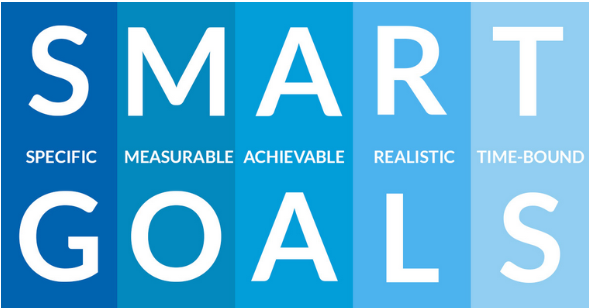WGU D077 OA Study Guide I - 2025 | Understanding SMART Goals and Porter’s Five Forces📖
Welcome, curious minds! Let’s talk about two things that sound more intimidating than they actually are:
- SMART Goals: A goal-setting framework ensuring objectives are Specific, Measurable, Achievable, Relevant, and Time-bound, helping individuals and organizations improve planning and performance.
- Porter’s Five Forces: A model that analyzes industry competition based on competitive rivalry, threat of new entrants, bargaining power of suppliers, bargaining power of buyers, and threat of substitutes, guiding businesses in strategic decision-making.
If you’re already rolling your eyes and muttering to yourself, ‘Oh great, more business speak,’ don’t worry – it’s about to get a whole lot more fun, simple, and even entertaining. Are these concepts uninteresting? Far from it, They are nothing but help to achieve smarter solutions, and superior strategies for success in your activities. Whether you are preparing to face WGU D077 OA questions gurus or are just curious about ‘why’ businesses actually behave the way they do, this guide is for you.
So buckle up! This article will ensure that by the time you are through you have gained an understanding that’ll make the popular contractual party smarter as well as possibly useful facts that’ll make the seem boring actually quite interesting especially at dinner tables. Ready to dive in? Let’s go!
How to Use This Guide for the WGU D077 OA Exam? 📖
The D077 Concepts in Marketing, Sales, and Customer Contact OA exam at WGU evaluates your understanding of marketing strategies, business objectives, and competitive analysis. This guide simplifies the key concepts of SMART goals and Porter’s 5 Forces to help you grasp the topics tested in the exam.
We also provide exam-style questions and practical applications to ensure you’re fully prepared for the questions on the WGU D077 OA exam.

Introduction to SMART Goals For D077 OA📝
It is important for anyone to set goals because this may seem very daunting if one doesn’t know how to go about it. But that is where SMART goals come in handy! SMART is an acronym, which means Specific, Measurable, Achievable, Relevant, and Time-bound. That’s why these five components help to make goal setting comprehensible and achievable. Now, let’s realize each part systematically so that it is simple to follow and apply.
If you’re a student who is learning concepts such as SMART goals while doing a course like WGU D077 OA, then this guide will be easy to read and understand.
What Are SMART Goals?

A SMART goal is a form of working approach to setting objectives that keep you on track, measure your progress, and ensure that you realize success. SMART goals are then plans that will guide you from point A to B. They’re not just wishful thinking but strategic visions that are unfolding into tangible programs with demonstrable output.
S – Specific
Being specific is the cornerstone of any effective goal. A specific goal clearly defines what you want to achieve, why it matters, and who is involved. It eliminates ambiguity and provides clarity, making it easier to take the first steps.
Key Questions to Ask:
- What exactly do I want to accomplish?
- Why is this goal important?
- Who needs to be involved?
Example: Instead of saying, “I want to sell more products,” a specific goal would be, “I want to sell 50 units of Product X by the end of the month.” This gives you a clear, focused target to work towards.
M – Measurable
Measurability ensures that you can track your progress and celebrate milestones along the way. A measurable goal provides concrete criteria to evaluate success and keeps you motivated by showing how far you’ve come.
Key Questions to Ask:
- How will I know I’ve succeeded?
- What evidence will prove progress?
Example: “Increase website traffic by 25% over the next three months” provides a specific percentage and timeframe, making it easy to measure progress using analytics tools.
A – Achievable
Achievability ensures that your goals challenge you while remaining realistic. Goals should stretch your abilities but not be so outlandish that they feel impossible. Consider your resources, skills, and time when setting goals.
Key Questions to Ask:
- Is this goal realistic given my current situation?
- Do I have the necessary tools and resources?
Example: “Improve customer satisfaction by 10% within six months by providing additional training for staff” sets a challenging but attainable goal based on practical actions.
R – Relevant
A relevant goal aligns with your broader objectives, whether personal or organizational. It ensures that your efforts contribute to something meaningful and avoids wasting energy on distractions.
Key Questions to Ask:
- Does this goal align with my long-term objectives?
- Why does this goal matter now?
Example: “Launch a new product targeting millennials, aiming for a 10% market share in six months” ties directly into a company’s growth strategy and market priorities.
T – Time-bound
Deadlines create urgency and help you stay focused. A time-bound goal ensures you have a clear endpoint and can plan your actions effectively.
Key Questions to Ask:
- When do I want to achieve this goal?
- What is the timeline for each step?
Example: “Reduce average customer response time by 20% within three months” provides a definitive timeframe, encouraging timely action and accountability.
Bringing It All Together For D077 OA
Suppose you are defining an objective when working on a small business. Instead of having a vague goal such as stating, “I want to develop my business,” you would say, “I want to earn an additional $ 1.5 million in the next six months through an online marketing campaign. This one is remembered by its acronym, SMART: Specific (it aims to raise the hospitality revenue), Measurable (by 15%), Achievable (using the current resources available), Relevant (aligned with growth), and within Time (within the six-month timeframe).
SMART goals are useful to streamline how dreams can be achieved. Because they explain major concepts in simple terms of implementing outcomes and practices, they offer a format that can help in attaining goals and increasing confidence daily.
Why Are SMART Goals Important?
There are several reasons why SMART goals are necessary they take an uncertain dream and narrow it down into an achievable plan. They give order and direction and make certain that every move is worthwhile. SMART goals are important because they reduce the element of guesswork, which is not useful, and keep everyone in the designated roles and responsibilities column. For instance, the strategic goal, ‘’Increase sales by 15% in six months’’, can be translated into tangible activities, the company can track learning and adjust.
The other advantage is that of motivation and accountability so that goals are achieved as planned. The Time-bound deadlines make the targets urgent and also ensure there is a record of the measurable outcomes for accomplishment. In business contexts, SMART goals streamline resource allocation, ensuring that efforts and budgets are concentrated on tasks that directly support organizational priorities. By aligning efforts with broader objectives, SMART goals empower individuals and teams to achieve success efficiently.
Examples of SMART Goals in Action
Let’s look at a few examples tailored to marketing and sales:
Sales Goals:
- Specific and Time-bound: “In spite of the current tough conditions, attain a sales increase of 20% for the next quarter through the implementation of a well-coordinated marketing strategy”
- Measurable and Achievable: “Increase customer acquisition by 15% within a period of six months through a better approach to digital marketing.”
Customer Service Goals:
- “Increase customer satisfaction ratings by 10 percent in the last quarter and increase staff training.”
- “Decrease the mean time to answer customer’s questions and concerns by 30% noting the implementation of a ticketing system in three months.”
Marketing Goals:
- “Achieve website traffic averaging of at least 25% in three months due to SEO optimization.”
- “Introduce three new product lines within the above fiscal year and aim for a 15% market share after six months.”
Tips for Setting SMART Goals
- Brainstorm with Your Team: Collaborate to identify realistic and meaningful goals.
- Use Data Analytics: Analyze past performance to set grounded targets.
- Review Progress Regularly: Adjust your approach based on feedback and performance.
- Invest in Tools: Use software to track progress, like customer relationship management (CRM) systems.
In Summary
SMART goals enable success by outlining a framework on how to set and monitor goals needed to accomplish a task. No matter if you are working on customer relations, enhancing the company services, or starting a promotional campaign, SMART goals help the goals reflect the direction and maintain the correct course. Whether you’re a student answering WGU D077 OA questions or a working professional who wants to thrive, understanding SMART goals is a crucial lead towards achieving your objectives.
Over time, the application of SMART goals becomes natural because it is critical in achieving students’ aspirations and aims of any working professional.
Introduction to Porter's Five Forces For D077 OA 📝
One key to making decisions is understanding competition in any industry you wish to invest in. That is where Porter’s Five Forces framework, introduced by Michael E. Porter in 1979 comes into play. This model assists in identifying competitiveness and its relationship in relation to the profitability of a market. Whether you’re preparing for WGU D077 OA questions or strategizing for your business, Porter’s Five Forces can guide you effectively. Let’s break it down step by step.
What Are Porter’s Five Forces?
Porter’s Five Forces framework focuses on five key factors that determine the intensity of competition and the overall attractiveness of an industry:
- Competitive Rivalry: The intensity of competition among existing firms.
- Threat of New Entrants: The ease or difficulty for new competitors to enter the market.
- Bargaining Power of Suppliers: The influence suppliers have over pricing and quality.
- Bargaining Power of Buyers: The power customers have to influence prices and demand.
- Threat of Substitute Products: The availability of alternative products that fulfill the same needs.
Breaking Down the Five Forces

1. Competitive Rivalry
This force examines how much competition exists within an industry. High levels of rivalry can lead to price wars, higher marketing costs, and reduced profitability.
Key Factors That Influence Rivalry:
- Number of Competitors: More competitors often mean fiercer rivalry.
- Industry Growth Rate: In stagnant industries, competition intensifies as firms fight for market share.
- Product Differentiation: Unique offerings reduce rivalry; similar products increase it.
- Exit Barriers: High exit costs (e.g., asset liquidation or reputational loss) keep firms competing, even in tough conditions.
Example: In the smartphone industry, brands like Apple and Samsung face intense rivalry due to similar target audiences and overlapping product features.
2. Threat of New Entrants
The more open the market structure that a firm operates in, the more forces of competition they experience from new entrant firms. This still shields the incumbents, as often is indicated by high entry barriers.
Barriers to Entry Include:
- Economies of Scale: Large firms can produce more at lower costs, deterring smaller entrants.
- Capital Requirements: Industries requiring significant investment (e.g., airlines) discourage new players.
- Access to Distribution Channels: Existing firms often have strong distribution networks, making it hard for newcomers.
- Regulatory Policies: Strict legal and licensing requirements can keep new entrants at bay.
Example: The automotive industry has high barriers to entry due to capital intensity and stringent regulations.
3. Bargaining Power of Suppliers
Suppliers hold the power to control the costs of inputs, quality, and availability of these inputs in the organization. The case when suppliers have the most influence is that they just limit a company’s profit.
Factors Affecting Supplier Power:
- Number of Suppliers Relative to Buyers: Few suppliers mean higher bargaining power.
- Availability of Substitutes: Alternative input sources reduce supplier leverage.
- Supplier Differentiation: Unique products or services increase supplier power.
- Importance of Volume to Supplier: Suppliers reliant on large orders from one company may have less power.
Example: In the tech industry, chip manufacturers like TSMC wield high bargaining power due to their dominance in semiconductor production.
4. Bargaining Power of Buyers
Customers can push for lower prices, better quality, or additional features. Their bargaining power is high when there are many alternatives or low switching costs.
Key Factors That Influence Buyer Power:
- Number of Buyers Relative to Suppliers: Fewer buyers mean higher individual leverage.
- Price Sensitivity: Cost-conscious customers exert greater pressure.
- Availability of Alternatives: Many options empower buyers.
- Buyer Knowledge: Well-informed customers can negotiate better deals.
Example: In the airline industry, buyers (travelers) have significant power due to the availability of online booking platforms that compare prices instantly.
5. Threat of Substitute Products
Substitutes can cap prices and reduce demand for a company’s offerings. This force evaluates how easily customers can switch to alternative solutions.
Factors Influencing Substitutes:
- Availability of Alternatives: The more substitutes, the higher the threat.
- Price-Performance Trade-offs: Superior performance or lower costs make substitutes attractive.
- Customer Loyalty: Strong brand loyalty can mitigate the threat of substitutes.
Example: In the beverage industry, coffee faces competition from substitutes like tea and energy drinks, which fulfill similar consumer needs.
Applications of Porter’s Five Forces
Porter’s Five Forces is not only a theory that has been developed, but it is an important tool for businesses that work to analyze their environment and establish strategies to compete with other actors in that environment. The application of the five forces helps business organizations gain great insights and understand the market competitor services.
- Market Entry Analysis is an important application of the framework. In order to facilitate the choice of entering a new industry, Porter’s Five Forces could be used to assess the feasibility of the move. For instance, if the threat analysis indicates highly high barriers of entry like high capital investment or powerful competitors, a firm may choose to improve on the entry mode choice or select a different ‘niche’ market. On the other hand, a poor competitive industry structure indicating low barriers and weak competitive forces is preferable.
- In Strategic Planning, the framework helps businesses align their goals with the realities of their industry. By understanding each force, companies can prioritize initiatives that strengthen their position. For instance, if supplier power is high, a firm might focus on diversifying its supply chain to reduce dependency on a few key suppliers.
- Another important use is the Risk Assessment. In particular, existing businesses might accurately analyze the potential threats of new entrants, powerful buyers, or substitutive products and create appropriate actions to dodge them. For instance, an object of analysis with a high threat of substitution may decide to invest in, for instance, product differentiation.
- Competitive Benchmarking in turn enables firms to consider their position in the market since the analysis of each force, impacts competitors. Such an analysis can reveal a business strength and the area that needs attention. For instance, a firm may discover that it has high buyer power in a market but that it experiences weakness regarding the threat of rivalry.
Using Porter’s Forces in the following ways helps business entities address the current forces and create long-term strategies that fit them.
Importance in D077 OA
The five forces model enables us to analyze the competitive forces with which an industry and its firms have to contend. It becomes clear that these forces open opportunities for businesses and expose threats that enable businesses to improve profit margins. Whether you’re researching or engaging in competitive markets or getting ready for WGU D077 OA, understanding this sort of model will provide useful knowledge that can be used to study markets and make the right decision.
Tired of reading blog articles?
Let’s Watch Our Free WGU D077 Practice Questions Video Below!

Final Thoughts on WGU D077 OA Success 📖
Congratulations on making it this far! By now, you’ve taken a deep dive into two powerful concepts: SMART goals and Porter’s Five Forces. These aren’t just theories to memorize—they’re practical tools to sharpen your thinking and give you an edge in business and life. Whether it’s setting goals that stick or analyzing competition like a pro, mastering these topics will pay off in more ways than one.
As you prepare for your final OA in WGU D077, remember to revisit these concepts and practice applying them to real-world scenarios. The exam isn’t just about understanding definitions; it’s about showing you can use these tools effectively. So, take your time, stay confident, and don’t forget—you’ve got this!
Good luck with your WGU D077 OA! With focus, preparation, and the insights you’ve gained, success is just around the corner.






